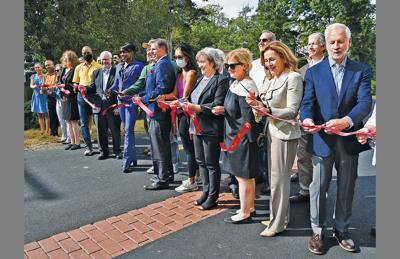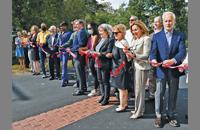Northern Virginia officials on Oct. 7 dedicated an enhanced section of the Washington & Old Dominion (W&OD) Regional Trail in Falls Church that separates cyclists from pedestrians.
“Northern Virginia has a great new Main Street and you’re standing on it,” said Falls Church City Council Mayor David Tarter. “One of the region’s best transit lanes had doubled in width – and I’m not talking about I-66. This one is environmentally friendly, healthy and clean.”
Officials broke ground on the $3.4 million project last year. The 1.5-mile-long section of trail, which spans between Little Falls and North West streets, has an 11-foot-wide path for bicyclists and an 8-foot-wide path for walkers and runners, separated by a 2-foot-wide textured, brick-colored median.
Planners deliberately did not raise the median above the other paths, so as to avoid the chance of accidents, said NOVA Parks executive director Paul Gilbert. Bicyclists may ride over the median if need be and will hear a sound like rumble strips under their tires if they do, he said.
The project is “truly nationally ground-breaking,” said Cate Magennis Wyatt, chairman of NOVA Parks, saying it included pollinator-friendly grasslands and modern stormwater-management technology such as swales, french drains and a contained, modular wetland system.
Magennis Wyatt credited NOVA Parks’ founders for their creative vision and foresight in turning an old railway line into a trail for recreation and commuting.
“Who of us would have had the knowledge to see what this could be?” she said.
Northern Virginia Transportation Authority (NVTA) CEO Monica Backmon said the agency looks forward to working with its regional partners to bring similar multi-modal solutions to fruition.
“Trails are a viable commuting mode,” Backmon said. “We need to make sure we are doing our part in getting people out of their cars and getting them on trails or other modes that help us all.”
When trails and bike lanes are low-stress and easy to use, more people use and enjoy them, said Kristin Frontiera, interim executive director of the Washington Area Bicyclist Association.
“Today, the W&OD is raising the bar on what a safe, accessible and fun trail looks like,” she said.
After the officials spoke, dignitaries cut ceremonial ribbons for group photos and staged another photo opportunity, this time with a break-away ribbon, that allowed cyclists to ride through. Kelley Westenhoff of Reston, who serves on the W&OD Trail Patrol, was the first to pedal through the ribbon.
The ceremony took place near where the trail crosses North Oak Street in Falls Church. A series of yellow bollards necked the bicycle lanes toward the pedestrian surface in both directions approaching the intersection. The bollards will be removed once Falls Church officials receive permission from the Virginia Department of Transportation to raise the roadway’s surface at the crossing as a safety measure, Gilbert said.
NOVA Parks is working with local governments along the trail to have similar projects included in their future transportation plans, Gilbert said. The agency now is designing a similar trail section for Arlington, he said.
Residents and trail users along the W&OD have expressed interest in having similar separated paths installed along the trail near them, Gilbert said. “The idea is over the next decade, hopefully, we will start transforming all of the urban areas with something like this,” he said.
NOVA Parks likely will press for a similar W&OD trail widening in Arlington, but some county residents already oppose that idea, said Arlington resident Bernard Berne.
The Falls Church project amounted to “basically paving the parks” and was pressed for by local bicycling advocates, Berne said. The initiative harmed surrounding meadowlands and removed many milkweed plants needed by monarch butterflies, he said.


